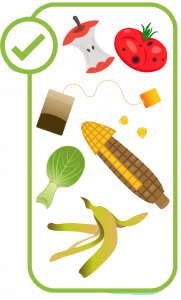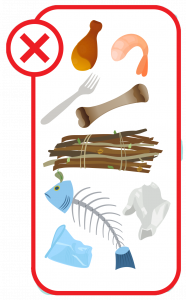If you’re interested in starting your own mini composting project at home, choose a dry, shady spot in your backyard close to a water source. The pile can be sectioned by using lawn edgers, wire mesh, garden pavers or long wood pieces. The process is simple and only requires a few basic ingredients:
Browns – Mulch, Leaves, branches and twigs provide carbon
Greens - Vegetables, food scraps and coffee grounds provide nitrogen
Water - Provides moisture needed to break down materials
Air - Decomposer microorganisms need oxygen to metabolize materials
When adding “greens,” it’s best to remember the following:
Accepted
-Fruits & Vegetables
-Tea & Coffee
-Eggshells
-Pasta, Rice, Grains
-Shredded, non-glossy paper

Not Accepted
-Meat
-Dairy
-Seafood
-Plastic/Trash

Step 1 - Add the waste materials and form a pile. Add your “browns” and “greens” in thin layers of 3 - 6 inches, lightly wetting each layer as you add it. It is important that every time you add fresh scraps, cover them with browns. Try to cover your bottom layer in lightweight browns to help air circulate to the center of the pile.
Step 2 - Sprinkle some garden soil or topsoil between layers to stimulate the composting organisms.
Step 3 - Use a pitchfork to turn the compost pile once per week. This keeps air and compost organisms circulating. If the pile seems too dry, add water in moderation. If it looks too wet, try adding more "browns" to help dry a pile.
Step 4 - A happy composting pile will gradually shrink, brown and start to emit an "earthy” odor. If it has a strong sour smell (anaerobic), that’s an indication that the pile needs more air and turning.
Step 5 - After two to three months, you should have a pile of cool, crumbly, earthy material that's ready for work. Add or dig in a thin layer of the compost onto your garden, and watch your plants grow.
If a composting pile on the ground of your backyard is not possible, you can also obtain a special composting bin at any home improvement store or online website. These bins range in size and can keep your compost nice and tidy.
Another option is through the University of Florida’s Institute of Food and Agricultural Sciences. As a Miami-Dade County resident, you can obtain a free composting bin by participating in one of their many workshops located throughout the area. Learn when the next workshop is scheduled by visiting www.ifas.ufl.edu

